S4 E3: Start of the Beekeeping Season… Finally!
- Greg

- Mar 29, 2023
- 14 min read
(Disclaimer: Wix, my website host, messed up and deleted all of my pictures causing a mass amount of faults throughout the site. I was meant to publish this post a few weeks ago but I was told not to make any changes until the problem was fixed. I'm sorry for the delay and I hope it won't happen again! Please see the end of the blog for more recent updates.)
Hello Everyone,
My title may be a bit pre-emptive as I’m starting to write this post on the 1st of March and outside is a bristly 4°C in the shade BUT March is the month when you start doing your final preparations for the beekeeping season ahead. By the end of March, hopefully, the temperatures will be clement enough to start our weekly inspections again - Huzzah!
And not a moment too soon may I add! I’ve been driving Kat mad riffling through our filing cabinet, pulling out files carefully and sighing heavily due to the lack of buzzy friends meandering around. I’ve gots the beekeeping itch that five long Winter months have distilled into a scabby rash (sorry for getting gross), (that IS gross! ~ Kat, ed) and I am SUPER excited to get elbows deep into a box of queens yet again ...
So, what, dear readers, should I (and you) have finished by the end of march?
Building equipment
All of those lovely deals that occurred in Autumn and Winter have taken their toll on the business account to say the least. Last year I ran out of equipment due an unusually warm Spring throwing the swarming impulse into the bee’s heads ridiculously early, which really threw me off my game.
In October, I bought myself 20 new brood boxes from Maisemore and Thornes sales which cost an arm and a leg, even with the discounted prices. I still find it so bizarre that when I first started beekeeping four years ago a top of the range brood box at full price was around £20 and now a brood box is over £60 (and that’s just for the box with no frames!).
As I mentioned in my last post, you really need a bunch of free time to build the equipment you have just taken a new mortgage out for. You may have seen (due to my constant posts about her) I had a newborn to contend with this year, meaning my time was taken up with nappy changes, pulling funny faces, communing through blown raspberries and generally supporting my incredible wife as best as I can. It got to January by the time I even had a chance to start building a brood box or two and to say I was getting a tad stressed is an understatement. Time really flies when you have a wee one, which I hadn’t accounted for.

Fortunately, I have incredible parents. My dad offered to build some boxes for me as long as I showed him how. An hour later, and he was putting them together in minutes. My father is a competitive being, so even though he had no rival or time limit he started timing himself and trying to beat his own little records. I left the flat packed equipment with him on the Tuesday and all 20 were done by Friday! He did give me some notes which I will give to you in case it helps in any future purchases.
“The Maisemore boxes are easier to put together, but the nails are a bit naff, you can’t wallop them like the Thornes nails.” - “The Thornes boxes are cut too tight; the wood keeps splitting when I hammer the nails in.”
Due to the issues he had, there have been a few ‘Hamilton Bodges’ here and there to get the boxes together when things went awry but all in all, they are together, watertight and solid enough to survive my inevitable blunders. I have to say though cannot fault his work in any way, as without him I wouldn’t have my equipment ready and raring for me to use by the end of this month. Thanks Dad!
Frames are the next challenge because Autumn 2022 Greg forgot to buy enough foundation like the fool he is, so this year I’m going to be making more foundationless frames that I have shamelessly stolen the design for from “the apiarist blog”. I’ve made these frames before and they are really useful mid-season for knocking down varroa numbers via a sacrificial brood technique. I’ve worked out that I’m going to have two foundationless frames per box which is fine because they can be places on the furthest edges and the bees will use them to store honey and pollen mostly.
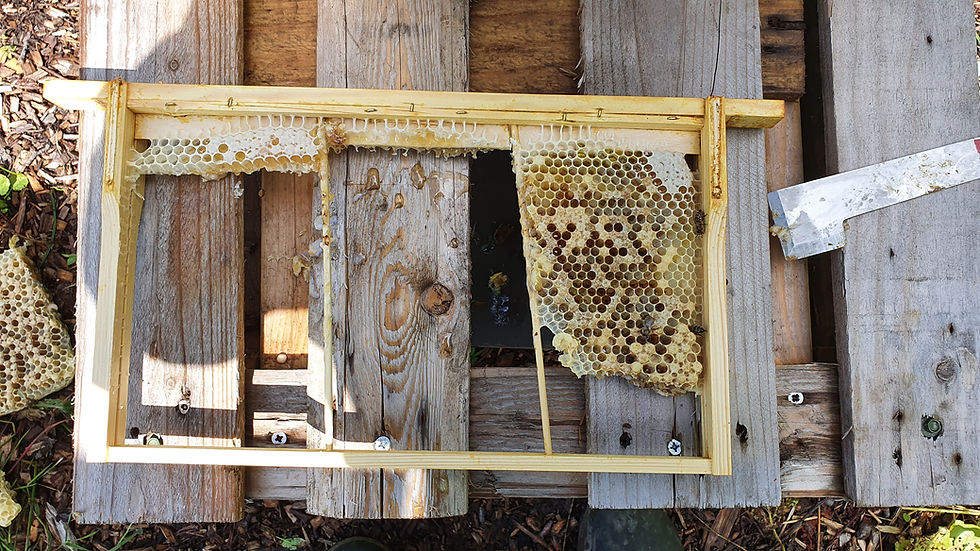
Fortunately, this year I haven’t had a new apiary to prepare (thank you Kat for reining me in – begrudgingly), like the past few years, so building Hive stands and doing land prep hasn’t been necessary. It’s amazing how much time and effort it can take up but Winter is the perfect time to do it all, so I hope you managed to get yours done!
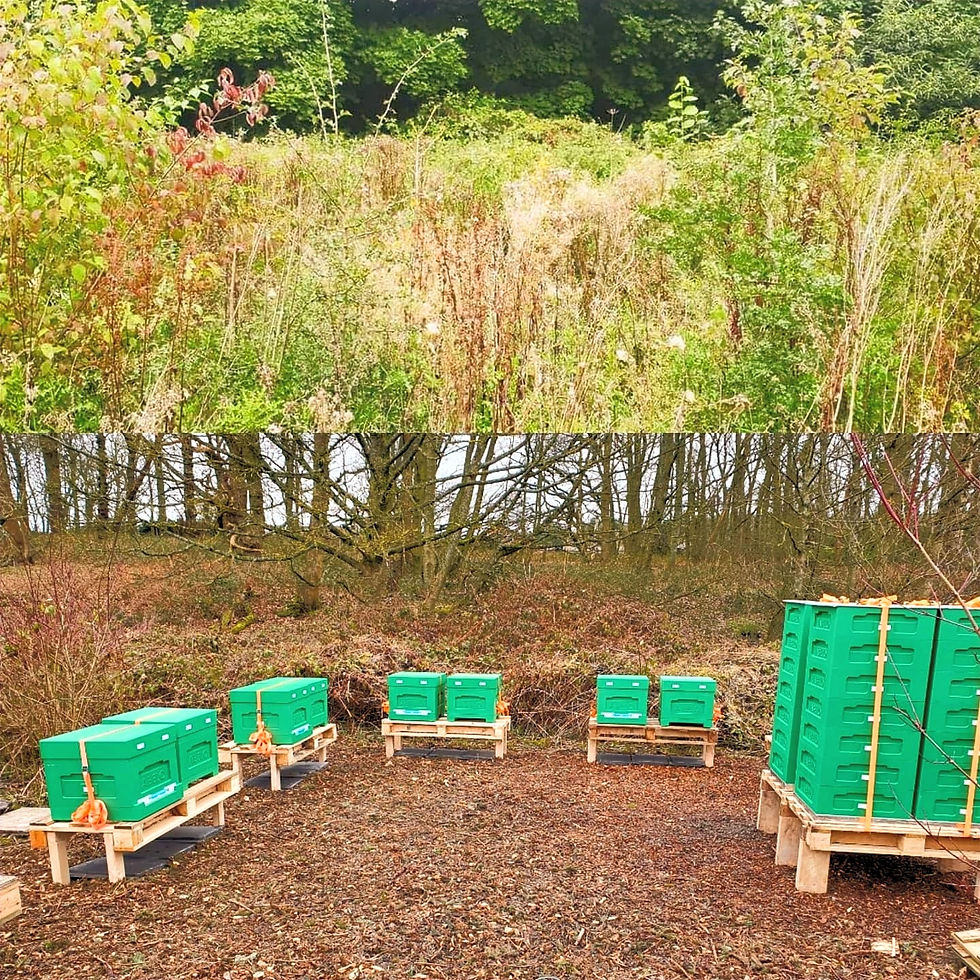
Moving Hives

Winter is the best time of the year to move Hives. Bees have a memory of three-ish days and they navigate themselves to a particular location, rather than a Hive, so during summer if you move a Hive to a different spot in the same apiary all of the field bees will fly out to forage and then fly back to the Hive’s original spot. You see them milling about very confused.
In Winter, bees are huddling next to each other and rarely breaking cluster for whole weeks, if not months. When the temperature changes in Spring they have no idea where they are so must re-learn their surroundings again from scratch. This means that any movement of Hives within an apiary is best to do in Winter. This year I’ve decided to fill my main apiary to full capacity (12 Hives) using my Overwintered Nucs. Even though the apiaries are around 3 miles away from one another, which is another option for moving Hives in summer, I want to clear my queen rearing apiary of colonies ready for me to start building Nucs in April.
A bit of advice for moving Hives and Nucs in Winter;
1. Make sure you seal the entrance before moving the colony. They may be in a cluster when it’s cold but if you’re moving them about a bit then the guard bees will go to investigate and these bees are spicy!
2. Strap up your box before lifting it. I tend to use bungee cords as they are really quick to use, and they hold the lid on quite securely.
3. Don’t bump the boxes too much as you could cause the cluster to drop and scatter among the Hive/Nuc floor. Not only could this damage the queen, but it also makes them lose a lot of heat that takes huge amounts of energy to get back.
4. Leave your car windows open and turn off the heat. If you place the colony into a warm car, they may break cluster thinking Spring has suddenly arrived. When you eventually bring them back outside the colony, that is scattered about on the frames, may go into thermal shock if they can’t form into a cluster fast enough.
5. Still wear a bee suit. They may be in a cluster and the entrance may be plugged up but if you’re as lucky as me, you may get a happy helper bee that tries to find warmth in the most unfortunate of places…
Once your Nucs and Hives are placed in their new homes, unblock the entrances and the bees will reorientate to their new position on the next warm day.
Clearing out dead Hives
Winter is known as the “great leveller” in beekeeping as only the fittest Hives survive the cold and damp. Many beekeepers get very anxious when it comes to Wintertime, and they mollycoddle their Hives to ensure they make it through. It’s completely understandable, especially if you only have a few Hives, as you know the personality of the Colony and have probably named the queen; they are in essence your pets and the thought of them perishing due to a mistake of yours is heart-breaking.

The most dangerous period for a colony isn’t Winter though, I wrote a blog about the death of one of my Hives this time last year because March is known as the “starvation month” for a reason. It is this month where the highest percentage of colonies collapse due to either food running out, dwindling colony size, disease or queen issues. The beginning of Spring catches most beekeepers off their guard as they think “the bees are flying about now it’s warming up so they must be safe!”
You see quite a lot of people posting about “when is the earliest I can do splits on my Hive now it’s got through Winter?” or “I’ve done my first inspection of my Hive already!” on the beekeeping Facebook pages. Then a few weeks later you see the same people posting “my Hive died! What did I do wrong?” You probably didn’t do anything wrong if this happens to you. I wouldn’t open the Hive until the very end of the month when it reaches around 15°C but the bees will have been dwindling throughout Winter and if the queen has died or is drone laying then the colony is doomed no matter what you do.
So, what do you do with your dead Hives? Leave them to be robbed out by the other Hives? Wait for a swarm to take it over in the next few months?
No…
Any Hive that you suspect has died needs to be moved away from the apiary, thoroughly investigated, and cleared out of dead bees.
If the cause of death of the Hive is due to queen problems or starvation, then it's not much of a worry. Just brush the bees out of the Hive and you can reuse the comb to make splits etc later on in the year even if the wax has gone a bit mouldy, the bees will clear it up. The main reason we clear the Hives away and investigate is in case of disease. During warm periods in March, bees are looking for any easy meal and if there is a weak or dead Hive then the surrounding colonies with rob any stores they have left. If this occurs, then any disease the dead/dying Hive has will have been passed on to every other colony in your apiary.
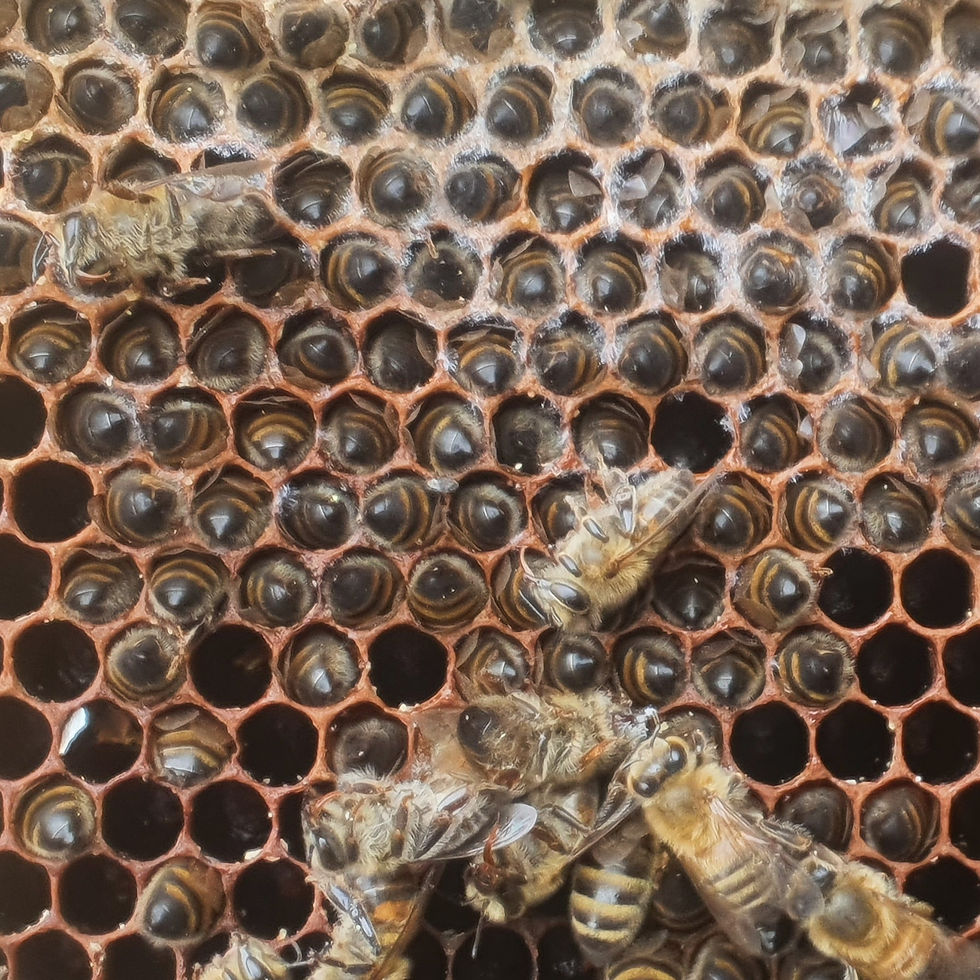
Removing the Hive from the apiary and placing it in your garage or shed takes the temptation to rob from your other colonies. Here you can take the frames out one by one and look for signs of disease.
The main things to look for are:
1. Lots of stores. If there are several frames of capped honey, then it means that the bees still had food available making starvation less likely. If the colony size is really small, then they might have been trapped in their cluster away from the food. This doesn’t tend to happen in the UK as our Winters are mild and even the coldest weeks are interspersed with days reaching around 5°C which the cluster can move around.
2. Big pile of dead bees. If the floor is scattered with bees, then it means the undertaker bees haven’t been doing their job for a while. This can mean that the cluster couldn’t afford for a few bees to break and get rid of the dead or that the bees were dying so quickly that the undertakers were overwhelmed. If starvation isn’t the culprit, then this is a big sign of disease.
3. The dead bees have deformed wings or other deformities. This clue points to varroa problems. Varroa feed and multiply on bee larvae. At this crucial stage in a bee’s life, they are more susceptible to viruses and infections which can prevent a successful metamorphosis. If the death is due to varroa you can brush the bees off and reuse the frames. Hopefully, there will be some capped brood somewhere in the frames that you can pull the larvae out of to check for varroa mites.
4. Misshapen larvae.
a. Dead larvae that are twisted in their cells and may be positioned on the upper, lower or side walls of the cell with an off-white, yellow, then brown and sometimes black colour is a massive indicator or European Foulbrood. You need to call in the NBU to come and check the frames too. They will advise you on what to do next.
b. If the larvae appear flat against the back of the cell and possibly some fluffy white growth, then this is “Chalkbrood”. Another indicator is that when you knock the frame some small, hardened larvae will fall out of the cells. Generally, these frames are okay to use again as this is usually a queen and humidity problem.
c. If the larvae are 'gondola' or 'banana' shaped with the head raised towards the top of the cell opening, or even have a blackish sac around them then it sounds like the colony died of “Sacbrood”. You don’t need to inform the NBU, but you do need to destroy your frames by burning them and disinfect your Hive body.
5. Sunken capped brood cells. Sometimes the moisture of a dead Hive can cause the cells to sink but if you see this then you need to get a matchstick or toothpick and pierce the cap. Wiggle the stick around a bit and slowly remove it. If there is any gooey trail on the end of the stick, you need to urgently call the NBU. They will do some tests and if there are positive readings for "American Foul Brood" then they will burn your Hive, frames and pile of dead bees there and then. You will probably have to take them to your apiary where they will test every other colony. AFB is extremely dangerous and highly infectious so much so that notifying the authorities of its discovery is the law.
(Please check out the links for images and more in depth indicators to look for when checking for diseases)
Remember, if you see anything that worries you or that you’re not sure on then contact your local BBKA and they will come and have a look with you. They have hundreds of years combined experience and are very willing to ensure there’s no disease in their areas. If there’s no signs of any disease but you’re still unsure, then just burn the frames and sterilise your Hive. Frames don’t cost a right lot and it's better to be safe than sorry!

Fortunately, I’ve only had a few colonies perish so far and all of them have been due to starvation or queen issues. Sadly, one of them was the swarm I collected two years ago (and wrote about) that was affectionately named “Wembeeley” by the owner of the shrub I found them in. Swarms are generally hard to predict when it comes to Winter as you never truly know the age of the queen that has swarmed. Queen Wembeeley was probably around 3-4 years old this Winter so had a good long life for a queen bee.
Checking food
Out of all of those issues a colony can have in Winter/early Spring, you can only fix one and that is food. During Winter you should heft/check your colony food supplies every 2-3 weeks but in March you should be doing it every week. This is the month that the bees break cluster most and the queen starts going into overdrive laying again, so they consume a HUGE amount of food.
Hefting is super easy to do and can be quite accurate at telling how many stores there are once you get the hang of it.
1. Place three fingers on your Hive floor and try to tilt the Hive using only the strength in your fingers.
2. If you can’t budge it, then your hive has lots of stores still. If you can move it, then try again with two fingers.
3. If this is difficult then there are still stores in the Hive, but they will be running out in the next month. If you can tilt it, then try one finger
4. If you can’t lift it with one finger but easily can with two, then the bees are in need of food. If you can lift it with one finger, then something is possibly wrong. Open up the crownboard and take a quick peek. If there is a big cluster of bees still alive then feed them, if they’re dead then take the Hive away.
Something else to take note of is the time of the year. If it's reaching the end of Winter and it still feels like the Hive is nailed down when you’re using three fingers, then there may be something wrong with the Hive as they clearly haven’t been consuming their stores. Maybe pop the crownboard and have a quick nosey to see if they’re okay. If they are fine then make a note, as you may need to give them more space earlier in Spring, if they’re dead or dying then take the Hive away.
Adding food is super simple. Get a block of baker's fondant and slap it over a hole in the crownboard. Job done. 1Kg should last at least 2 weeks depending on the size of the Hive so if you go back after a week and its gone, make sure you heft the Hive as the bees may have taken the fondant down to store in their combs.
I’ve gone through 60kg of baker's fondant already this year, Buckfast bees are definitely the hungriest of our Hives so please be warned if you are looking at getting some Buckfast bees, Winter can get expensive!
Moving Nuc colonies into Hives.
I haven’t done this yet due to the cold still hanging about, but it is definitely on my list of jobs by the end of March. Its best to keep Overwintered Nucleus colonies in their Nuc boxes for as long as possible as the smaller the space, the easier it is to keep warm. This being said, as the queen starts going into overdrive laying and more bees are produced, the box will get far too cramped very quickly. It’s definitely an art form as moving them across too soon may kill them from cold and leaving them too late may cause them to swarm early, in turn probably ending in their demise.
I tend to move the Nucs over into their new Hive box when one of the following happens:
1. The box is so full that the bees are hanging out the entrance.
2. The bees are starting to build wild comb in the Nuc roof.
3. The forecast says that the daytime temperature won’t go below 10°C during the following 14 days.

Once I move a Nuc over to a Hive I start feeding them with a few litres of 1:1 sugar syrup (1L of water : 1Kg of sugar) each week until the beginning of April when they should have started to fill the Hive with bees and any frames of foundation will have been drawn out. At this point it's usually the start of the Spring flow so you can relax a little and just give them more space to flourish.
Giving Hives more space

I find the start of the Spring flow hard to predict. I thought I had it fettled and then last year it started mid-March and as mentioned before, every Hive started throwing up swarm cells… and I started having palpitations... This year I’ve decided a new strategy. I’m going to give the Hives more space earlier but to ensure they can still cluster if it gets cold, I’m going to put the extra space below them in the form of another brood box.
As colonies grow and collect resources the brood area starts moving down as honey is stored at the top of the Hive. This is why we always put honey supers on top of the brood box, rather than below. With my plan, the bees will start storing honey from the Spring flow in their brood box and due to the extra space I’ll be giving them below, they will just start moving down into the new box like in nature. I’m hoping that this will quell any swarm instincts that they have for a bit longer, as it was hard work keeping up with them last Spring!
Once their original brood box is full of honey and the queen has moved down, I will put a queen excluder on the bottom box and place a couple of supers in between the two brood boxes. If this plan works out and I don’t get any swarm cells this Spring, I’ll start making this a staple routine in my calendar. Another benefit is that I may get some Spring flow honey to harvest, which I’ve never had before.
Anyway, that’s my plans for this month. It’s taken two days to write this blog so now I’m going to sit and stare out the window longingly while it rains outside, dreaming of the next few weeks when I can be with my buzzy girls again.
Hope you are safe and well,
Greg
Update 10/3/23: There is now an inch of snow covering everywhere… C’mon spring, hurry up!
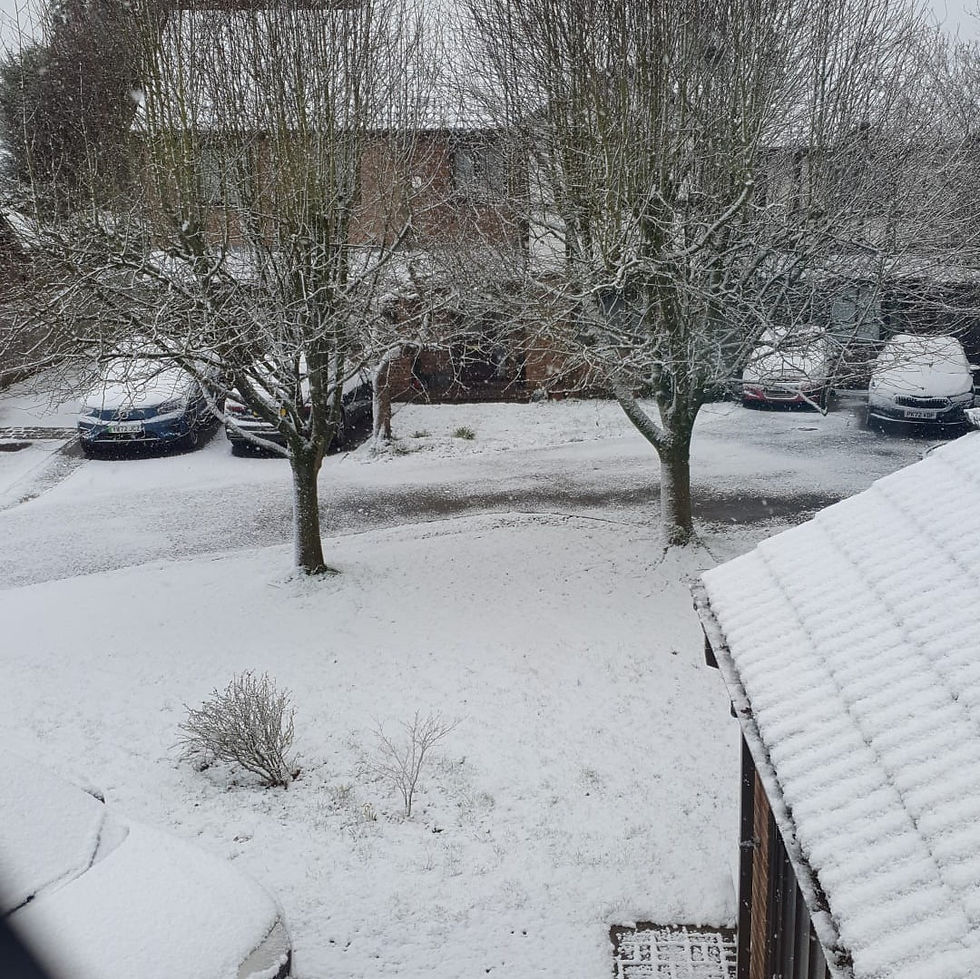
Update 12/3/23: Since writing this blog post, there was a spate of cold (but not freezing) rainy days which I took advantage of by moving five overwintered Nucs to their new home in my main apiary. Here are the pictures of how it went:
Update 20/3/23: My nail gun just fell to pieces in my hand while making frames… bugger…

Update 20/3/23: The daytime temperature this week isn’t going to be below 15°C! (Hurray!), unfortunately it will be raining sideways… (Boo!)

Update 22/3/23: Gots me a new stapler for half the price of the original! Screwfix for the win!
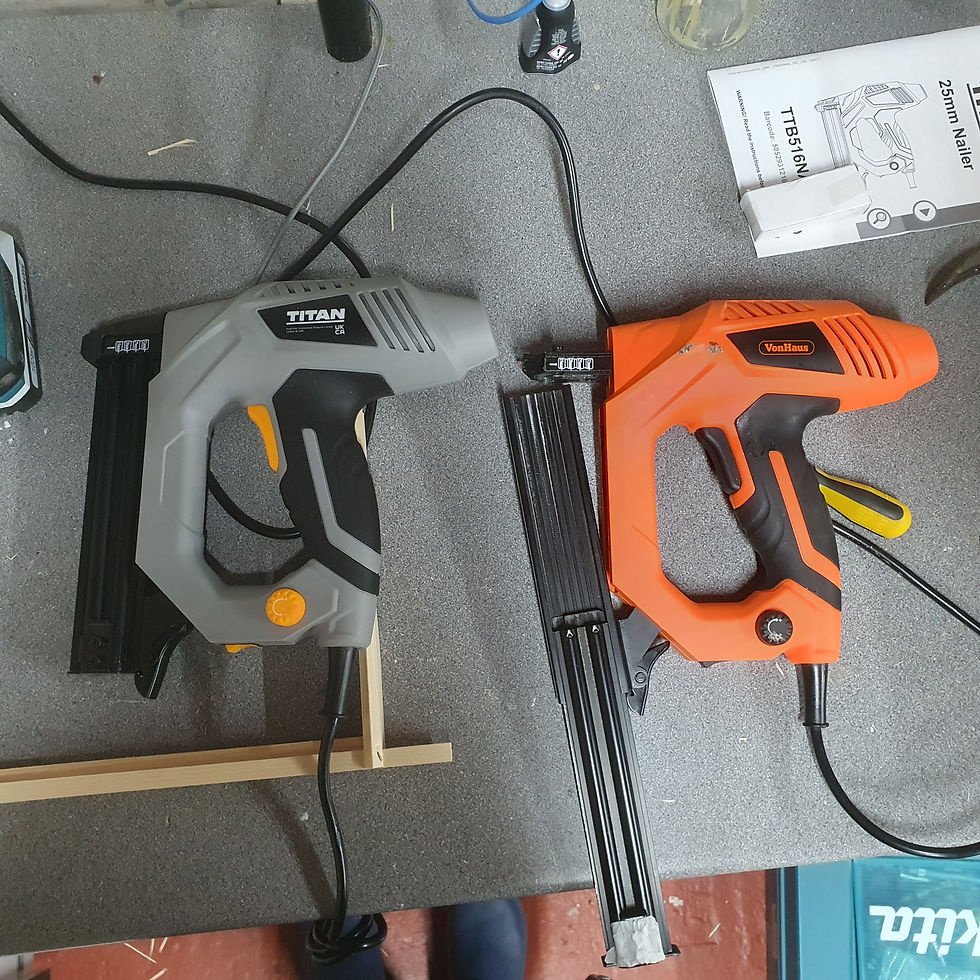
Update 23/3/23: Managed to transfer two nucs into hives in between the tsunamis. Two down, three more to go!
Update 29/3/23: My blog site has finally been fixed so I can now post this. Sorry for the delay!























































Comentarios